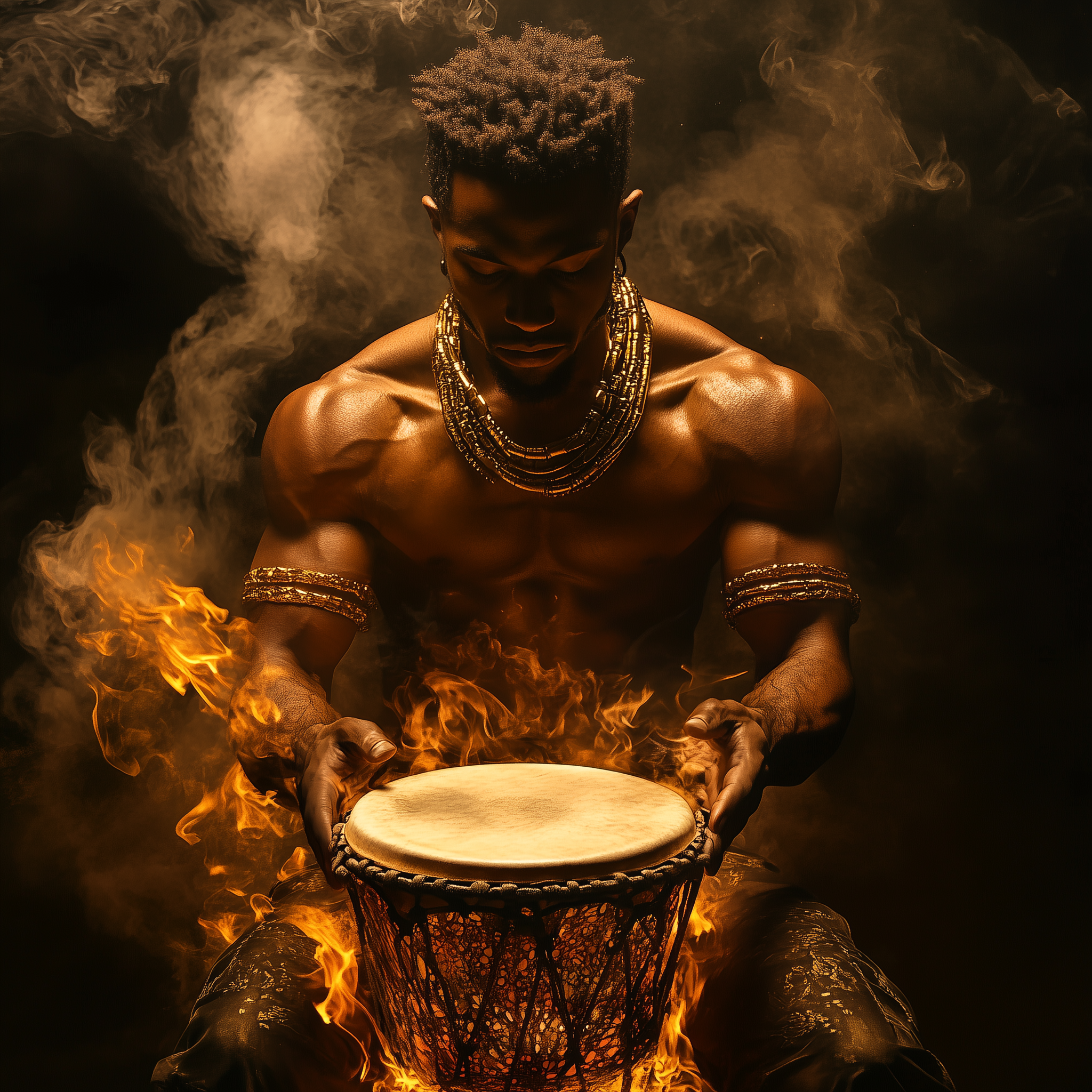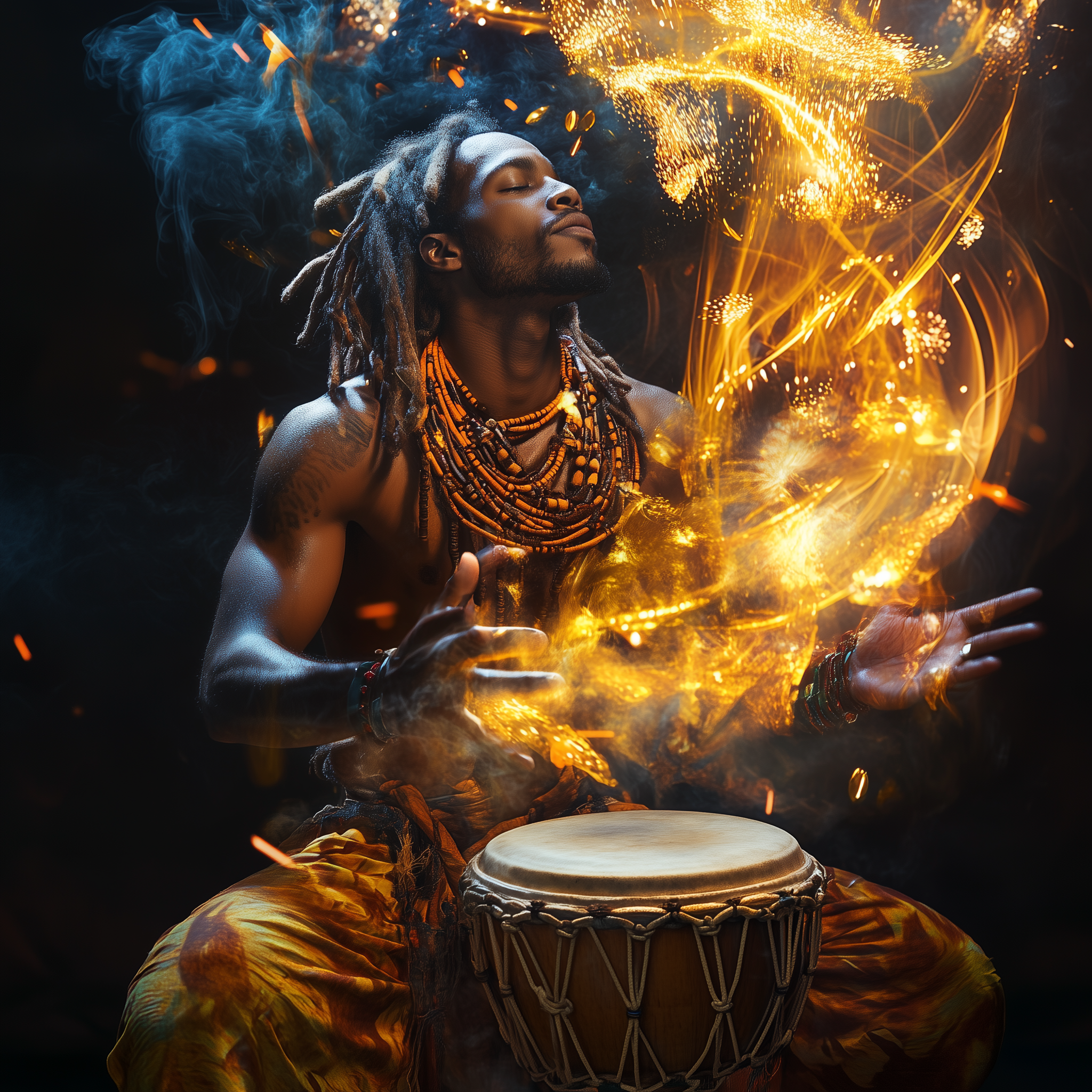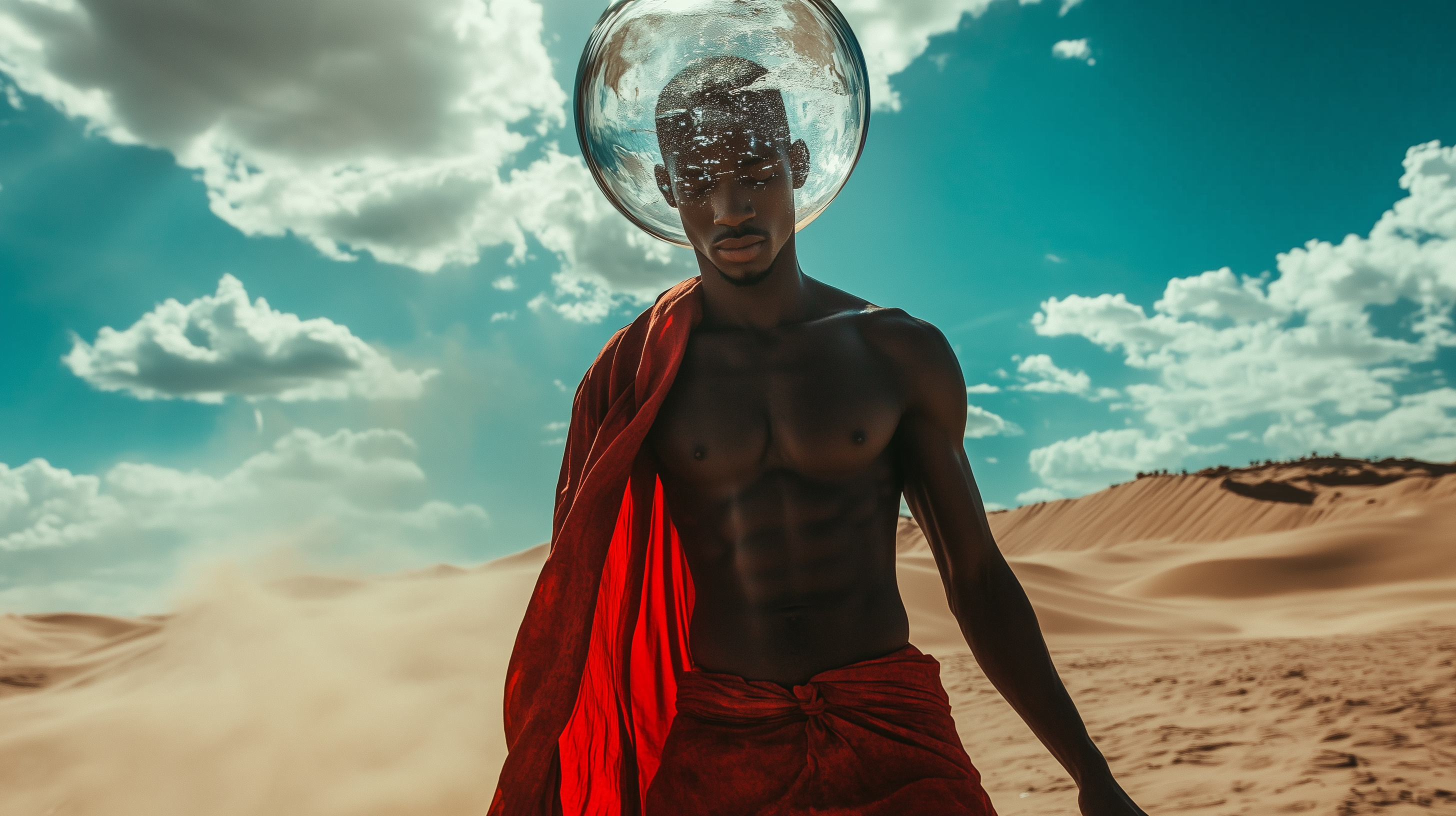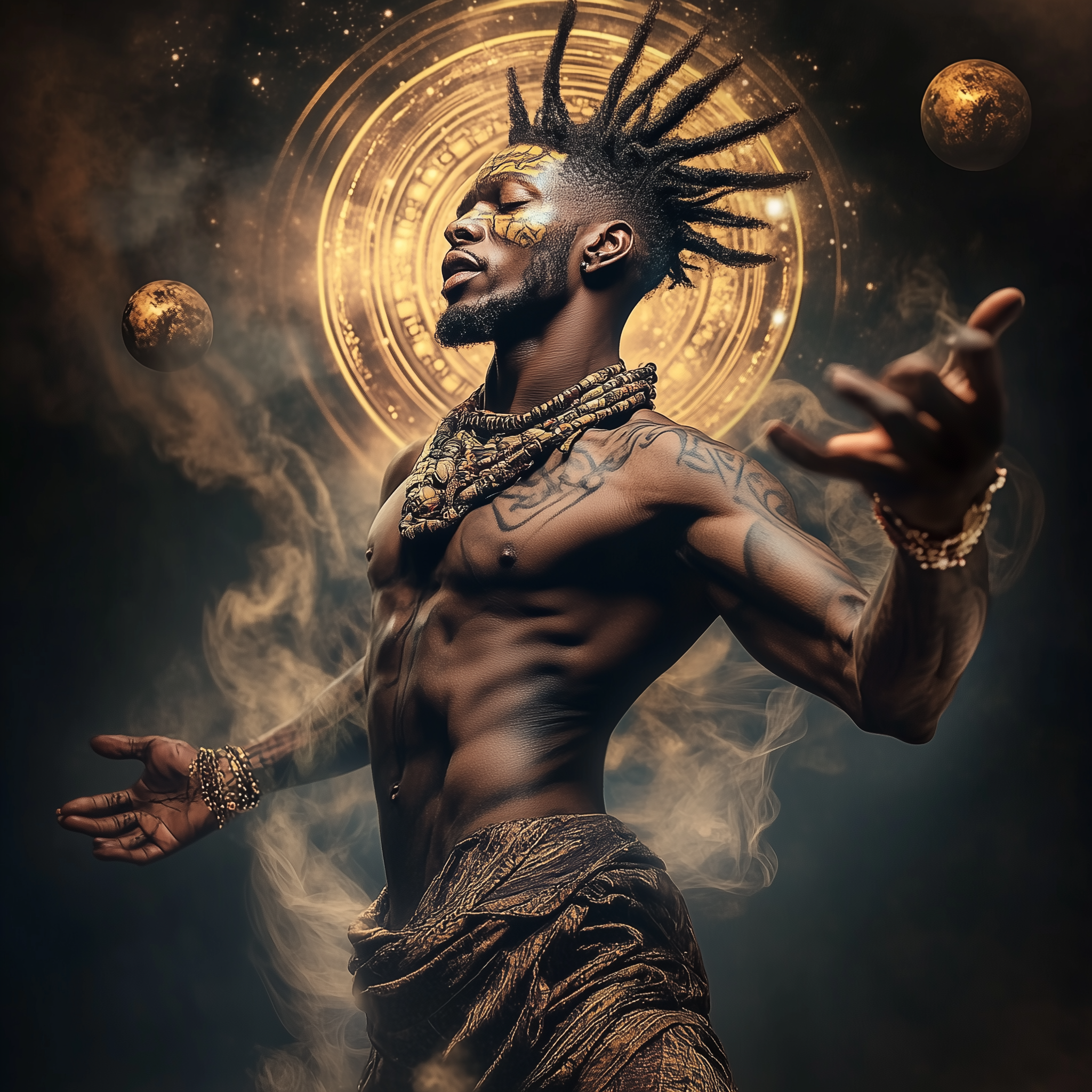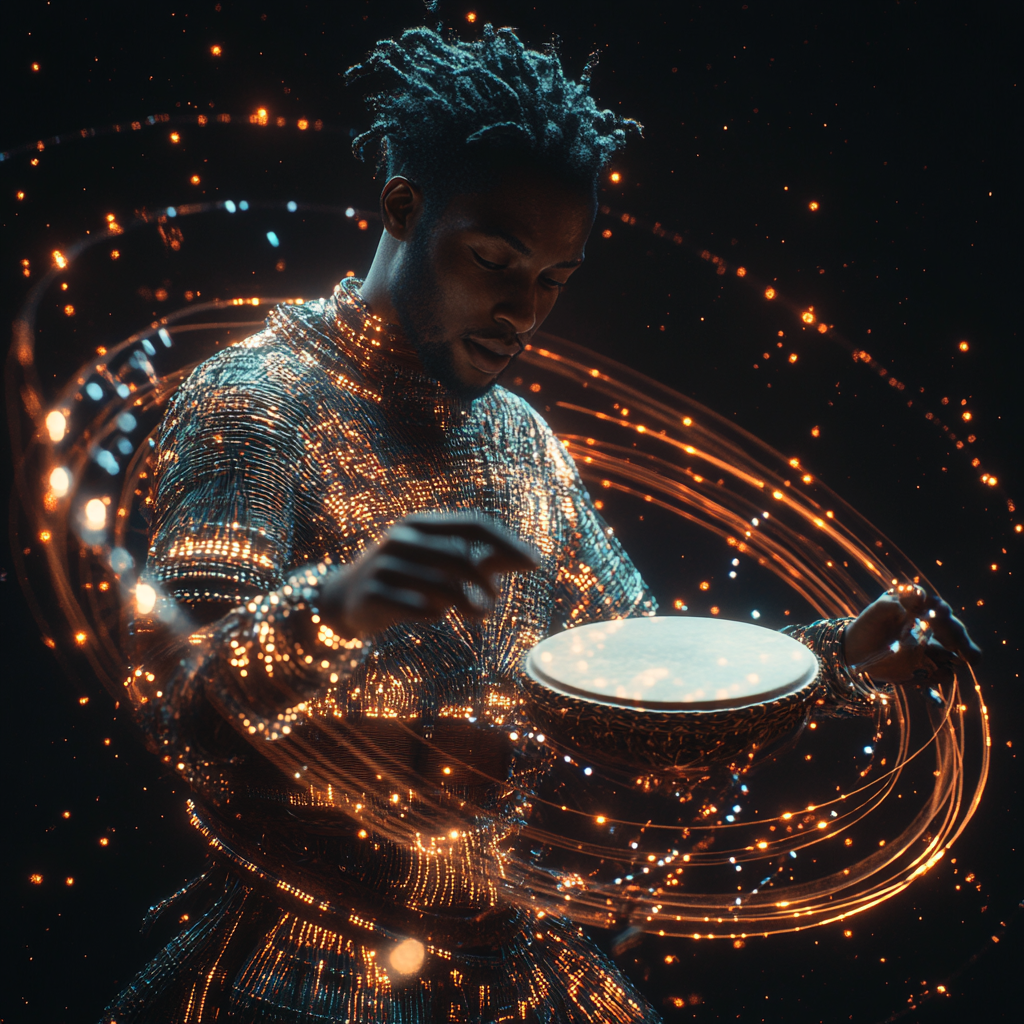 THE SPECTACULAR DANCING AFRICANA BODY
THE SPECTACULAR DANCING AFRICANA BODY
The Africana Body is so spectacular in its abilities that even the gods want to borrow it!
The exchange between spirit and man is related to time. To Rhythm. The body locked in time has heightened emotional and sensory experience. The spirit covets this and exchanges it for the knowledge that comes from being outside of locked time.
Polyrhythm is the technology through which locked and “unlocked” time is brought so close together that exchange is possible. The collapsing of time, so to speak, or rather in our point of view, the spiralling of time. The Africana Dancing Body possesses the ability to break open time. As mentioned before; the body without rhythm and movement is locked in time. As we move to certain rhythms and with certain movements, time is made non-lineal. Hence ancestral spirits and other spirits, not held by time, can enter or can dialogue with us. We barter the body, which is condensed in time. Through lending our body spirit then, can experience a heightened sense of emotion and other corporeal pleasures, in exchange for the knowledge that they leave behind. Knowledge which comes from not being bound by time, from being outside of time or to be able to be copresent across time. The cord of consciousness (the spine), and the disruption of the lineal, is central to Africana temporal and dimensional technology. Hip and Spine is the key to time and to spirit.
The Afrocentric body holds a profound place within philosophical and cosmological frameworks, with significant implications for dance and spirituality. The interplay between the body and its surrounding space influences movements, perceptions, emotions, and freedoms, particularly evident in spiritual and artistic practices. Many Africana worldviews emphasize the validity of the unseen realm of spirits and deities, treating it on par with the material world. Ancestral knowledge systems often attribute spiritual causes to physical phenomena, acknowledging the active presence and agency of ancestors, spirits, and deities within the everyday community and lives of individuals.
Africana spirituality embraces a reciprocal relationship between the materialized body and the spirit world. The body’s temporal nature, governed by rhythm and movement, allows spirits, unbound by time, to experience heightened emotions and corporeal pleasures through this exchange. Spirituality and embodiment are intertwined in a complex system where the body acts as a conduit between the visible and invisible worlds.
Dance and spirituality view the body not just as a dancing entity but as a situated body in context and space. The sensoriality, layout, and morphology of a space can shape the body’s movements, creativity, perceptions, and emotions. Different spatial configurations may prompt specific actions and sensorimotor patterns, impacting the body’s orientation and engagement with its surroundings.
Polyrhythm plays a crucial role in breaking open time, enabling spirits to interact with humans and engage in a non-linear temporal experience. The key lies in the hips and spine, disrupting the linearity of time and facilitating spiritual exchange. Through rhythm, dance, and presence, spiritual entities are called and invoked, transforming the entire ritual site through multiple sensory mediums, including sound, movement, taste, and smell.
Ashé, a concept often associated with Orisha beliefs, represents the power to manifest into the world. In African Diaspora rituals, ashé imbues the space through rhythm, dance, and sensory elements, creating an environment where spirits are present not just through sound and movement but also through feeling, taste, and smell.
In Vodou and Ifa (Orisha) traditions, ritual objects and shrines increase the likelihood and frequency of interactions with spirits, inducing action and creating a community of initiates. The ritual space is carefully designed to generate an emotional contagion, attracting spirits who desire to experience the sensations present in the materialized body, setting the stage for a bartering process between spirits and humans.
Within much of West Africa, ancestral spirits hold authority over the living, and their wisdom and experiences are believed to be passed down as a legacy to their progeny. In Vodun practices, a Vodunsi is a person chosen and initiated by the Vodun spirits, under their full protection and guardianship. To become a Vodunsi, one must undergo an intensive initiation process within the esoteric home, a sacred place that fosters a deep spiritual connection.
By understanding the Afrocentric body within its holistic philosophical and cosmological context, we can appreciate the profound influence of rhythm, dance, and spirituality in shaping embodied experiences and connecting with the spiritual world. The exchange between the materialized body and the spirit realm reveals a complex web of interconnections that enriches both physical and metaphysical existence.
The Africana body is not confined to a singular existence; it has the remarkable capacity to house not only one spirit but also the collective urgencies and necessities of an entire community. This embodiment of communal essence is a profound aspect of African and diasporic traditions, one that holds the power to transform not just individuals but entire societies. It’s a concept seldom explored in performance theory but carries immense significance in the realm of social justice.
“In the unity of a singular body channeling the essence of a community, we find the convergence of urgency and intent, a force that has the potential to drive powerful change.”
The act of condensing the hopes, struggles, and aspirations of an entire community into a singular body is an act of tremendous potency. It’s a crystallization of intent that, in itself, becomes a force for social transformation. In this process, individual ego is transcended, and a profound sense of both community and individuality is enforced simultaneously. It’s a cleansing of intent, a purification that readies both the collective and the individual for the challenges ahead.
During the tumultuous times of the civil rights movement, figures like Bernice Johnson Reagon engaged in a practice she aptly coined “Shifting the Air.” When faced with the imminent threat of violence from the police or racist white mobs, they turned to the power of music and song as a transcendent force.
“The resonant power of song and voice became a vessel for channeling the urgency, spirit, and humanity of the community towards the oppressors.”
Their voices vibrated with such intensity that they condensed the humanity of the community to an extent where it became impossible for the oppressors to carry out their murderous intent. In essence, they transformed the air of potential violence into a forceful yet peaceful demonstration. “Shifting the Air” not only saved lives but also shifted the narrative from one of violent suppression to one of unyielding determination for civil rights.
This practice underscores the profound impact of African diaspora art practices, showcasing their potential not just within the realm of art but in the broader context of societal transformation. It epitomizes the essence of ChoreoNommo—the power to manifest a new reality through artistic processes.
“Art, for the African diaspora, is not a mere luxury or entertainment; it is a lifeline, a conduit for survival, a bridge between past and future, and a testament to the resilience of the human spirit.”
In our pursuit of recognition within the narrow definitions of art, we must never forget that for us, art is more than aesthetics; it is a means of preserving lives, creating a sense of belonging, consecrating spaces, and passing down the wisdom of generations. It embodies the principles of Sankofa, the act of looking back to retrieve what was lost or forgotten, and Ubuntu, the recognition of our shared humanity.
“I am human; therefore, nothing human is alien to me.” For me heard quoted by Maya Angelou. These words remind us that art, in all its forms, is an expression of our shared human experience, a force that has the capacity to transform and heal not just the individual but the entire world. In a world rife with challenges, let us never underestimate the profound impact of art and its potential to shift the air, to transform violence into peace, and to create a more just and harmonious world for all.
POLYSPIRIT PRACTICES: THE BODY AS A COSMIC CONDUIT
PolySpirit practices in Africana and Caribbean traditions challenge the artificial divide between body and spirit. In this spiritual paradigm, the body doesn’t just host the spirit; it is an intrinsic part of the spiritual realm. It’s a departure from the idea that the spirit is superior and must transcend the body. Instead, it embodies the concept that the highest power lies in their inseparable union.
The Polyrhythmic Dance of Time and Presence
The concept of rhythm is central to this union, serving as a connective tissue between temporal experiences and cosmic wisdom. Within traditions like Haitian Voudou, the body becomes a living, breathing axis mundi, where earthly and spiritual realms coalesce. Each rhythmic drumbeat, every dance movement, awakens not only a distant spirit but the spirit inherent in the body itself. The “flashes of spirit” are instances where the body shows its inherent divinity, its capability to be more than flesh and bone but a crucible of cosmic energy.
Groove: The Energetic Exchange of the Spiritual Body
The concept of Groove, although often approached through secular lenses, taps into this indivisible union of body and spirit. From the community halls where Gospel music resonates to the Hip-Hop clubs where beats and rhymes catalyze movement, the Groove isn’t merely a catchy rhythm. It’s a manifestation of the body’s own spiritual nature, a sacred echo that reverberates through ancestral lines, invoking a shared memory that is both corporeal and spiritual.
The Pocket of Unity
When musicians talk about being in the “pocket,” it’s that magical moment where sound, rhythm, and movement are in perfect harmony. But this is not just a musical phenomenon; it’s a spiritual one. The pocket is the space where the corporeal and the spiritual, the “You” and the “We,” coalesce into an indivisible entity. The experience of Groove in this pocket becomes a celebration of the body’s inherent spirituality, a collective affirmation that we are more than the sum of our physical parts.
The Sacred Everyday: Where the Corporeal Meets the Cosmic
The PolySpirit practices and the concept of Groove teach us that the sacred is not far removed in distant temples or lofty philosophical theories. It resides within our bodies, within the way we move, the way we engage with rhythms, and how we connect with others. This everyday spirituality refutes the dichotomy of body and spirit, making each of us a living testament to cosmic power.
Our Body, The Spiritual Archive
Our bodies serve as archives, not just of biological information but of spiritual wisdom, ancestral memories, and collective experiences. When a spirit “lends” itself to a body during a PolySpirit practice, it’s not merely visiting a separate realm. It’s recognizing and activating the body’s own inherent divinity. And when we feel the Groove, it’s not just our spirits that are uplifted; it’s a complete, holistic experience of spiritual corporeality.
Africana Diaspora traditions offer us an expansive lens to reimagine spirituality, one where the body is not a separate entity but an integral aspect of our spiritual existence. The highest power is not in transcending the body but in realizing its innate divinity, in recognizing that it too is a manifestation of spiritual energy. PolySpirit practices and the power of Groove are not merely paths to this understanding; they are vibrant affirmations of it.
The message is clear: the body is not just flesh and bone, to be transcended or overcome. It is a radiant form of spiritual energy, capable of communing with ancestral spirits, with the cosmos, and with the communal beat of a shared Groove. It is in this sacred union of the corporeal and the cosmic that we find our highest power, our most profound connection, and our truest selves.
Polyspirit practice is grounded in the profound transmission of kinetic intelligence from spiritual entities to the dancer. Infused by ancestral and divine energies, the dancer acquires a heightened understanding of movement, leading to exceptional virtuosity and a deepened connection with both their body and the essence of dance.
The Repository of Ancestral Movement
Ancestral spirits embody centuries of dance experiences and techniques. As they merge with a dancer, they pass on this rich tapestry of kinetic knowledge. This is not mere imitation of past dances but a direct transference of intricate movement patterns and rhythms, granting the dancer access to a vast and diverse movement repertoire.
Deepened Bodily Connection
Armed with this expansive kinetic intelligence, dancers develop an acute awareness of their physical form. They instinctively understand the capabilities and nuances of their muscles, tendons, and bones. This intimate knowledge transforms their dance from mere movements to deeply emotive expressions, where every gesture carries meaning and intent.
The Culmination: Enhanced Virtuosity
The inherited wisdom leads to a natural elevation in the dancer’s abilities. Movements become more precise, complex routines feel intuitive, and the dance exudes a grace that seems otherworldly. It’s a blend of skill and profound understanding, reshaping the dancer’s relationship with their art.
POLYSPIRIT PRACTICES CONTINUED
In Polyspirit practices, this act of unlocking is quite unlike an academic lecture or a sermon. Wisdom here is transferred and imparted in a space outside of the ego, beyond the limits of individualistic consciousness. The ego, with its need for ownership, definition, and control, is absent here. This absence is not a loss but a release, opening a celestial highway where wisdom flows not as a possession to be grasped but as a universal life force to be experienced. Because the ego is not present to question, doubt, or reinterpret the wisdom being imparted, what gets transferred is pure, unadulterated understanding. This is a deeply subversive act, one that bypasses our social conditioning to deeply commune with something far older and more profound.
It’s no surprise, then, that these practices necessitate a fundamental trust of the self. This trust is not narcissistic or self-indulgent but deeply spiritual—a faith in one’s own body and spirit as vessels capable of holding and channeling this ancient, cosmic wisdom. You are trusting your corporeal form to carry memories and experiences that have danced through the aeons, from the communal fires of ancestral villages to the complicated soundscapes of modern-day existence. You trust your body to be both narrator and narrative, to weave and be woven into a continuing story that transcends individual lifetimes.
To attain this trust, a surrender is required—stay out of struggle, release control. This is not a passive act but one of profound courage. It is about relinquishing the struggle to “know” in favor of the wisdom of “being.” It’s akin to entering a river, not to fight the current but to become one with its flow, its ebbs, its cascades. By surrendering, an interior expansion occurs, an expansion so intense, so overwhelming in its profundity, that it can’t help but manifest externally. This is felt both by the practitioner and the audience as a palpable shift in energy, an elevation, a sacred “elsewhere” that we all enter together.
This interior expansion reflects a divine form of hospitality where one opens up not just one’s home but one’s very being to the presence of others—community, ancestors, spirits. It’s a form of radical openness, a deep rapport that goes beyond mere collaboration. You’re inviting these spirits to co-inhabit your being, to co-pilot your corporeal vehicle. You’re allowing yourself to be transformed by them, and in doing so, you’re also transforming them, adding a new chapter to an age-old story.
The embodied memories thus unlocked can be profoundly life-altering, not just for the individual but for the community, bridging gaps between the past, present, and future. These are memories that don’t just live in museums or history books but in the very sinews and cells of our bodies. And as these memories are unlocked, as this wisdom flows, we find that we’re not just learning but becoming—a transformation that turns each of us into a living archive, a breathing library of ancestral wisdom and future potentialities. This redefines the very notion of what wisdom can be, liberating it from the prisons of individual ego and social construct, and returning it to its rightful place—as a shared, deeply embodied cosmic dance.
QUANTUM PRESENCE AND THE PROBABILITY AMPLITUDE OF POLYSPIRIT PRACTICES AND CHOREOWANGA CHOREOGRAPHY
Certain concepts in Africana spirituality could probably best be understood in “westernized” terminologies through quantum physics. Our ancestors and our deities are superpositioned beings, meaning they exist in multiple states. They are both present and not, they are active parts of our communities and environments and do interact with us. In quantum mechanics superposition is the ability of a quantum system to exist in multiple states at the same time. This means that a quantum particle, such as an electron or photon, can exist in multiple states or locations simultaneously.
Until «measured» or «registered» a superpositioned quantum system will be in multiple states of existence. Measuring it will usually result in it being where it has the most probability amplitude of existing and with the behavior/qualities that are also the most probable. Probability amplitude can be thought of as a measure of the likelihood of an event occurring in a quantum system
Ritual Probability Amplitude
Specificity is therefore such a big part of Africana spirituality. I will explain using the example of Oya or Iyansan a goddess of protection, wind, storms, change and many other things, exists in multiple iterations, personalities, qualities and states. When one calls on her one does not call to all and every state of being in which she can exist, but seek specificity, a particular version or a particular of many different states in which she might behave. This specificity where one defines the parameters of Oya in multiple ways, through naming, storytelling, placement of resonant objects, rhythms, colors, dances, chant and more is a way of “measuring” or “registering” the state of Oya, and as such, like with superpositioning, increasing the probability of her appearing in that particular state. The ritual could be said to be designed to increase the probability amplitude of her expressing herself in the desired way. Also, the probability of her appearing at all. Those who are familiar with rituals know that sometimes other iterations or even other deities who are related show up instead. Osun for example, a sister wife of Oya, might show up instead. Knowledgeable participants in the space know how to receive, guide, and eventually guide the visitor out of the energized space, allowing the coding of specificity to continue as to attract the correct force. Any visiting entity will always be received and shown due respect. This also point to the philosophy of polycentricity and the allowance of layering and co-existance rather than a focus on singularity. Layers enrich, and facilitate abundance.
A ritual for Oya or to attract Oya is designed to make the superpositioned energy that we identify as an aspect of Oya, the most likely energy to appear in the ritual space. The other half is that it is also designed to make the place the most likely place for Oya to appear. It is two sided. Specificity is there both for the likelihood of Oya appearing or wanting to appear, and also that the correct aspect of Oya, or that Oya alone appears. Therefore, the place is set to resonate and entangle with her.
Ritual Entanglement
In the realm of quantum mechanics, entanglement describes a phenomenon where two or more particles can become linked in a way that their properties become dependent on each other, even at great distances. This notion challenges the classical concept of locality which proposes that objects are only influenced by their immediate surroundings. Similarly, in many African philosophies and cosmologies, objects and people can also be connected in such a way. In such worldviews, the past, present, and future are not necessarily considered linear and influence can flow or connect across these temporal parameters. As a result, our relationship with our ancestors is one of entanglement. Despite the fact that we may not exist in physical proximity to each other, we affect them, and they affect us in a non-linear, multi-dimensional way. Additionally, in many African spiritual and cultural practices, ritual serves to reinforce this entanglement with our ancestors and deities, providing guidance, connection, wisdom, and even the transference of certain qualities. By strengthening these bonds of entanglement, we can enhance our ability to affect events beyond our immediate surroundings.
In a way similar to how the principles of entanglement work in quantum mechanics, symbolic objects like wanga bags or juju bags can also work in a representational manner of entanglement, where the effects on one object or element instantaneously affects that of another. This is not a supernatural phenomenon, but rather an acknowledgement of how the laws of nature work. In fact, this kind of understanding is deeply rooted in African philosophies and cosmologies. The ritual is designed to strengthen the entanglement between entities/persons/objects. This is done through resonance, but also through the strengthening or specificity aspect of enhancing the attributes of a particular version/state/quality of the thing/person/entity. This approach is present in African ancestral practices across the globe. Yvonne Daniel in her book Dancing Wisdom references this in her chapters on Embodied Botany.
Those of us familiar with African Diasporan healing chants know that they not only contain information and knowledge, but that the practice is of enforcing the qualities of a particular herb for example. Lets say you are using cloves as a pain killer for tooth ache. You would chant and enhance its numbing and healing qualities by “reminding” it of who it is and these qualities. Strengthening its identity so to speak, but also taking its “measurements” as to “lock it” or encourage it to exist in that particular phase of its existence as a multifaceted and also superpositioned system. This idea of strengthening something is also central in the Africana healing practices, where focus is more on strengthening the sick in order to heal themselves, rather than attacking the illness.
Similarly, Bantu people in Southern Africa are known to sing people “back” if they are lost in grief or are experiencing a crisis. The content of the song are then qualities which these people possess and which others admire. There is also the practice of educating children this way. I myself witnessed a child who had stolen something being sat down by his elders. Instead of telling him how bad he was, they sat him down and started telling him memories of times he had impressed them, where he had shown wisdom, good judgement, caring. The way it was done did not seem to have the goal of shaming him, but rather of condensing and strengthening these identities within him. Affirming his good qualities, and these as his “core”, he was strengthened to take responsibility for his lapse of judgement, say he was sorry, make suggestions to ways to remedy and restore trust. This was a modeling of eldership which was truly inspiring. It was also a reminder of the deeper knowledge that lies in ritual, if we only remember to apply them to our daily lives.
This aspect has also entered Gospel singing and other more westernized or even secular versions of African Diaspora lives. There are many songs who remind God of Gods qualities and identity.
Ritual Tunneling Explored
Once again, I am drawn to the fascinating domain of quantum mechanics to illuminate certain aspects of Africana ritual. This time, I incorporate the concept of tunneling. Tunneling, or quantum tunneling, is a phenomenon where a particle can traverse a potential barrier even when its energy is below the barrier’s height. This ability is rooted in the wave-like nature of matter, allowing the particle to exhibit wave characteristics and occupy multiple positions simultaneously. The probability of a particle successfully tunneling through the barrier is influenced by the barrier’s height and the particle’s energy— with the probability increasing as the barrier height decreases and the particle energy increases.
Typically, realms exist on different planes, overlaid yet not directly in co-lapping existence. Tunneling, or more precisely, the altering of vibration and the flux generated in the ritual place, facilitates the “thinning” of barriers, thereby augmenting the energy that might enable tunneling and deep entanglement. This deep entanglement is often referred to as possession by some, but I prefer to call it PolySpirit practices, where the body becomes a vessel for more than one spirit through the processes of tunneling and entanglement. The degree of entanglement or co-presence is nuanced and depends on various factors, which I will not delve into deeply here. The preparation of the body to become a capable vessel for receiving or channeling more than one spirit is integral to the ritual itself. Dance and music are pivotal and central elements of this preparation. Most deities have their preferred rhythms, tempos, and movements, resonating deeply with these rhythmic expressions. Our spirituality is vibrantly expressed, sang, danced, and musically orchestrated, embodying what one might describe as being Nommoed.
Central to much of African spirituality is the concept of exchange or bartering. This market-like framework encompasses the transfer of energy to precipitate an altered state or result. In the domain of physics, this natural transference of energy is pivotal to both entanglement and tunneling, necessitating specificity, resonance, facilitation, and the amplification of a specified energy to diminish barriers and enable permeation. Once the conditions for transference have been satisfied, the actual exchange can commence
.
The Africana Body is endowed with such remarkable capabilities that even the gods seek to engage with it. The interaction between spirit and human is intrinsically tied to the concept of time, specifically to rhythm. As the body moves in rhythm, it experiences a heightened state of emotion and sensation, which the spirit desires and is willing to exchange for the knowledge inherent in existing outside the linear confines of time. This exchange fosters a synergistic relationship, orchestrating a harmonious dance between the physical and spiritual realms, thereby unveiling a rich tapestry of experiential knowledge and transcendental engagement.
POLYTEMPORAL ORIENTATION
The concept of poly-temporal orientation in Africana cosmologies and artistic expressions is an embodiment of a worldview where temporal linearity is replaced by a more holistic, cyclical, and simultaneous understanding of time. This approach perceives the past, present, and future not as discrete and sequential but as interconnected realms that constantly inform and infuse each other.
This temporal perspective is deeply ingrained in the cultural narratives, where storytelling is not constrained to linear progression but weaves through events and experiences in a way that mirrors the complex interplay of causality and synchronicity characteristic of human consciousness. Such narratives might start in the present, draw on ancestral history, leap forward to envisage future implications, and circle back, thereby defying the chronological order that dominates Western narratives.
In this framework, the anecdote of reacting to a comment at work becomes a mosaic of experiences, not just the immediate context but an amalgamation of interconnected events and states of being, from the mundane to the historical. The recounting becomes a tapestry of life itself, reflecting the broader Africana experience where every moment is a confluence of various temporal streams.
The Orisha practice from the Yoruba religion exemplifies this, as it navigates through the myths and stories where deities’ experiences are not bound by human notions of time. Their stories are invoked and experienced in rituals as eternally present, transcending linear time, thus embracing poly-temporality. In the rich tapestry of Orisha narratives, the stories of deities such as Ogun and Shango are not static mythologies but dynamic and evolving tales that encapsulate the essence of poly-temporality. Ogun, the deity of iron and war, could concurrently be depicted as the consort of Oya, the goddess of winds and transformation, or Oshun, the goddess of water and fertility. Similarly, Shango, the god of thunder and lightning, might be revered as a once human king, a deified ancestor, or an elemental force present at the creation of the world.
These varying accounts are not held in contradiction but are understood as multifaceted expressions of the deities’ natures and stories that are ancient, actively unfolding in the present, and continuing to evolve into the future. They represent the non-linear and omnipresent qualities of the Orishas—stories that are perpetually relevant and always in a state of becoming, just as they always have been.
In ritual and worship, these narratives are not recounted as historical events fixed in time but as current realities that worshippers engage with in the here and now. This engagement is both a reenactment and a contemporary interaction, reflecting the belief that these divine stories are not merely relics of the past but are alive and influential in the present and will continue to be so in the future.
This perspective reflects a worldview in which the divine is immanent, existing in an eternal now that transcends human timelines. Such stories, with their fluidity and resilience, offer powerful insights into the nature of time and existence in Africana cosmologies. They challenge the linear temporal constructs of Western thought and open up spaces for multiple realities to co-exist, intertwine, and inform each other, providing a rich framework for understanding the complexity of life and the universe.
Moreover, this poly-temporal approach is manifested in the rhythms of Africana music. Polyrhythms and polymeters represent not just musical techniques but are expressions of this profound temporal philosophy, where multiple tempos coexist, allowing for a layered experience of time. The interplay between pitch and rhythm can alter the perception of time, with lower tones often inducing a sensation of elongation and depth, while higher pitches can create an experience of acceleration and intensity.
The contrast with Western temporal orientation is notable, particularly in the industrialized world’s emphasis on quantifying and managing time—a concept intrinsically linked to production and economic frameworks. In contrast, Africana and Indigenous Knowledge Systems, as well as their artistic expressions, prioritize the subjective experience of time, embracing its fluidity and inherent multiplicity.
Thus, in the realm of performance and storytelling, time becomes an elastic medium through which Africana artists and communities navigate, express, and understand their realities. The layering of time in poly-rhythmic patterns and spatial organization is not only a technical or aesthetic choice but a profound engagement with a worldview that recognizes the simultaneous existence of multiple realities and temporal dimensions. It is through this engagement that Africana art and cosmology offer a rich, complex, and deeply interconnected experience of existence.
TEMPORAL POLIFICATION IN AFRICANA DANCE: WEAVING TIME INTO A SYNESTHETIC SYMPHONY
Temporal Polyfication: Weaving Time in Africana Dance and Spiritual Practices
Defining Temporal Polyfication
Temporal Polyfication, a concept coined by Thomas Talawa Prestø, refers to the intricate manipulation and multifaceted experience of time within Africana dance and spiritual practices. This technique challenges the conventional, linear understanding of time by creating a synesthetic symphony where past, present, and future coexist and intertwine. Through rhythmic, kinetic, and sensory engagement, Temporal Polyfication reshapes the audience’s perception of time, transforming their experiential reality.
Context and Significance
Temporal Polyfication is deeply rooted in Africana cosmologies, where time is often viewed as cyclical and multidimensional. This perspective can be seen in various cultural practices and narratives, such as the Yoruba Orisha traditions, where deities’ stories are experienced as perpetually present rather than confined to historical timelines. These narratives are not static but evolve, reflecting the ongoing interaction between different temporal realms.
In performance, particularly in Africana dance, Temporal Polyfication manifests through the use of polyrhythms, polycentric movements, and dynamic spatial arrangements. These elements combine to create a temporal landscape that defies linear progression, inviting participants to experience multiple temporalities simultaneously.
The Metamorphosis of Experiential Time in Dance
Temporal Polification, an artistic technique employed within Africana dance, is an intricate manipulation of the audience’s perception of time. Choreographers and composers ally to bend the passage of moments into a subjective experience, intertwining the sensory modalities of rhythm, movement, and vision. The resulting alchemy doesn’t just alter the perception of time—it reshapes the experiential reality of the audience, guiding them through a labyrinth of elongated moments and fleeting eternities.
Synesthesia and Temporal Dynamics
Time, in the context of Temporal Polification, is a canvas upon which a multitude of sensory experiences converge. Deep, sonorous tones and grounded, expansive movements stretch the audience’s perception of time, making moments seem to linger beyond their physical duration. Conversely, lighter, sharper movements and sounds create a perception of brevity. This choreographic and compositional mastery exploits the audience’s synesthetic tendencies, crafting sequences that defy objective chronometry.
The Parallax Effect in Kinetic Time Perception
Temporal Polification introduces a “Parallax” effect in kinetic perception—a multidimensional temporal illusion. Africana dance becomes the vessel for this illusion, with its inherent polyrhythmic and polycentric structures providing a layered temporal tapestry. The audience is invited into a state of polytemporality, experiencing multiple tempos and rhythms concurrently, warping their sense of linear time.
The Sculpting of Temporal Experience
In Temporal Polification, the choreographer acts as a temporal sculptor, shaping how the audience experiences the length and order of the performance. What may be a drawn-out sequence is perceived as a quick succession of events; a brief flurry of movement feels like a prolonged narrative. This art form taps into the elasticity of time perception, engaging audiences in a more profound and intimate dance with the unfolding performance.
The Subjective Nature of Time in Engagement
The subjective experience of time during a performance echoes the variability of temporal perception in our daily lives. Temporal Polification leverages this variability, transforming the audience’s engagement with the performance. Time becomes less a measure and more a medium, a dimension through which personal narratives and emotions are projected upon the stage, enriching the collective experience.
Creating Ethereal Temporal Landscapes
Africana dance, through Temporal Polification, transcends the physical stage, creating imaginoscapes where time loses its linearity. The fusion of light, sound, and movement crafts an augmented reality, merging the tangible with the temporal, the actual with the imagined. This confluence of past, present, and future in a single performative moment invites audiences into a realm of temporal plurality and artistic depth.
Continuing from the discussion of Temporal Polification and its impact on the audience:
This delicate balance of temporal perception fosters a psychological environment where attendees oscillate between focused attention and an almost involuntary absorption of the performance. Such a state is akin to a trance, where the stimuli—visual, auditory, and kinesthetic—provoke not just thought, but a profound, embodied reaction that encompasses both the present moment and an eternal, inner narrative. The differentiation between active analysis and passive dreaming diminishes, and in this space, audience members are subtly coaxed to “daydream” within the performance’s reality.
This ethereal state, reminiscent of mass hypnosis, takes cues from profound traditional performance practices, like those found in Vodoun ceremonies, as well as the complex rhythmic and melodic structures of the Black church. These practices, deeply emotive in their nature, serve to amplify the audience’s experience of movement and time, enveloping them in the narrative’s sonic and kinetic waves.
To maintain this hypnagogic atmosphere, variability is crucial—the performance must adeptly fluctuate its rhythmic and thematic intensity. Linger too long in a rhythmic pattern or a specific thematic phase, and the spell is broken, the audience reverts to a state of analytical detachment. The paradox lies in the complexity, a nuanced disorder or “swing quality,” that engages the brain yet also promotes a state of mental repose, allowing for a broader absorption of the spectacle.
Variations in movement quality, sonic textures, rhythmic complexity, and the layering of polyphonic elements are strategic; they ensure constant cerebral engagement while lulling the analytical mind into a malleable, imaginative, and receptive state. This controlled chaos prevents the diverse elements of the performance from overwhelming the senses or descending into cacophony. Instead, it crafts a symphonic tapestry that invites the audience to experience the art on multiple sensory and emotional levels.
Thus, the act of orchestrating Temporal Polification within Africana dance transcends mere performance—it invites the audience into a shared journey through time and space, an experiential tapestry woven with threads of memory, anticipation, and the profound immediacy of the present. This multisensory engagement ensures that the impact of the performance is not fleeting but endures as a resonant experience that continues to echo within the audience long after the dancers have left the stage.

